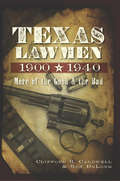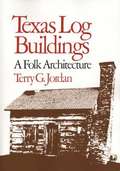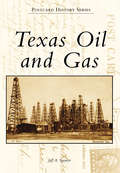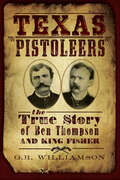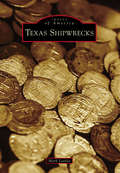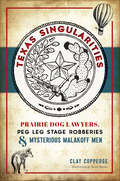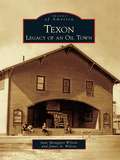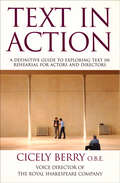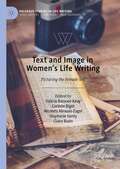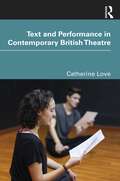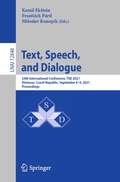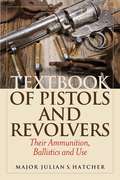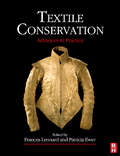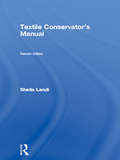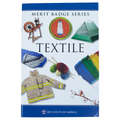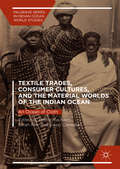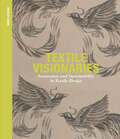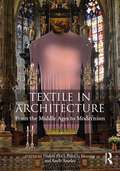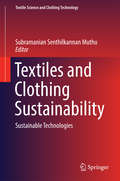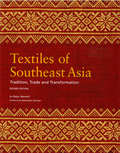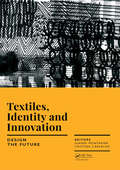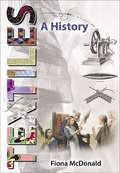- Table View
- List View
Texas Lawmen, 1900-1940: More of the Good and the Bad (True Crime Ser.)
by Clifford R. Caldwell Ron DelordLawlessness in Texas did not end with the close of the cowboy era. It just evolved, swapping horses and pistols for cars and semiautomatics. From Patrolman "Newt" Stewart, killed by a group of servicemen in February 1900, to Whitesboro chief of police William Thomas "Will" Miller, run down by a vehicle in the line of duty in 1940, Ron DeLord and Cliff Caldwell present a comprehensive chronicle of the brave--and some not so brave--peace officers who laid down their lives in the service of the State of Texas in the first half of the twentieth century.
Texas Log Buildings
by Terry G. JordanOnce too numerous to attract attention, the log buildings of Texas now stand out for their rustic beauty. This book preserves a record of the log houses, stores, inns, churches, schools, jails, and barns that have already become all too few in the Texas countryside. Terry Jordan explores the use of log buildings among several different Texas cultural groups and traces their construction techniques from their European and eastern American origins.
Texas Oil and Gas (Postcard History Series)
by Jeff A. SpencerTexas Oil and Gas documents in postcards the rapid growth of the Texas petroleum industry from its beginnings near Corsicana in the 1890s through the next several decades of oil booms throughout the state. The young 20th century opened with the Lucas Gusher at Spindletop in 1901. Thousands rushed from the oilfields of Pennsylvania, Ohio, and West Virginia to find work and riches. Continued drilling success along the Texas Gulf Coast transformed Houston into a major city and the Beaumont area into a major petrochemical center. Through the 1910s and 1920s, oil booms occurred in North Texas, the Panhandle, Central Texas, and West Texas. The giant East Texas oilfield, the second largest North American oilfield to Alaska's North Slope, was discovered in 1930. Texas oil replaced coal as fuel for the nation's railroads and provided fuel for our military in two world wars.
Texas Pistoleers: The True Story of Ben Thompson and King Fisher (True Crime)
by G. R. WilliamsonThe Vaudeville Theater Ambush of 1884 went down in history as one of the most famous gunfights in San Antonio, but the killing that night of Ben Thompson and John King Fisher, two of the most notorious pistoleers of the day, became something of a mystery. The two men entered the theatre just before midnight on March 11, and less than an hour later, both lay dead, shot down in what for all accounts was a true massacre. The responsible gunmen never were prosecuted for their crimes, and Thompson and Fisher--a mere mention of either man's name was enough to put the fear of death in any opponent--have been widely ignored since. Now, historian G.R. Williamson brings to light the mystery and the myths surrounding these men and their infamous deaths in Texas Pistoleers.
Texas Shipwrecks (Images of America)
by Mark LardasThe Texas coastline and offshore waters are flat, shallow, featureless, and filled with shoals. Texas waters are subjected to extreme weather, not just hurricanes and tropical storms but also northers and seasonal gales. This, combined with two centuries of naval warfare off Texas waters, produced many shipwrecks of all sorts, from Spanish treasure fleets to simple working boats. The ships of pirates, navies, cotton traders, immigrants, fishermen, and oil shippers line the Texas coast, cover the sea bottom off Texas, and blanket the bottom of Texas rivers. Each wreck has a story, romantic or repellent, prosaic or unusual, but all intriguing.
Texas Singularities: Prairie Dog Lawyers, Peg Leg Stage Robberies and Mysterious Malakoff Men
by Clay CoppedgeTexas, that most singular of states, conceals an entire parade of peculiar events and exceptional people in the back pages of its history books. A Lone Star man once (and only once) tried to bulldog a steer from an airplane. One small Texas town was attacked by the Japanese, while another was "liberated" from America during the Cold War. Texan career choices include goat gland doctor, rubbing doctor, striking cowboy and singing cowboy, not to mention swatter, tangler and dunker. From gunslinger Sally Skull to would-be rainmaker R.G. Dyrenforth, Clay Coppedge collects the distinctive odds and ends of Texan lore.
Texon: Legacy of an Oil Town
by James A. Wilson Jane Spraggins WilsonFrom 1924 to 1962, Texon was a model company oil town in Reagan County, Texas. Pittsburgh-based Big Lake Oil Company developed the town site next to the Big Lake Oil Field and Santa Rita No. 1, the discovery well on University of Texas lands in the Permian Basin. Pres. Levi Smith ensured that company employees and their families enjoyed comfortable housing and community amenities, including a grade school, hospital, nondenominational church, theater, swimming pool, and baseball park, as well as a café and dry goods, grocery, and drugstores. By the end of World War II, the Big Lake Field's declining production meant a smaller workforce and a declining Texon population. Plymouth Oil assumed ownership in 1956 and six years later sold out to Marathon Oil, which ended company support for the town. At annual reunions, however, former residents--who remember Oiler baseball, scouting, Sunday school, and Labor Day celebrations--have kept the Texon experience alive.
Text In Action: A Definitive Guide To Exploring Text In Rehearsal For Actors And Directors
by Cicely BerryFollowing on from the widely acclaimed The Actor and the Text - which was addressed directly to the actor - Text in Action is drawn from Cicely's group work experiences, encompassing the viewpoint of the director as well. To begin with, the author explores language from a cultural and personal perspective. In these days of management jargon and internet technology are we losing touch with the ability to communicate fully?' Is the deeper imaginative world being left unexpressed? The main body of the book contains detailed, practical exercises for actors and directors during the rehearsal process. All exercises will be tied to specific scenes, leading to a fuller exploration of the rext. Text In Action analyses the imagery of plays, speech structures, the physicality of language and emphasises the importance of finding a collective voice. Cicely's guidance on the matter of voice will help actors find relationships and situations through the text in a unique way, in order to make it more dynamic and creative.
Text and Image in Women's Life Writing: Picturing the Female Self (Palgrave Studies in Life Writing)
by Valérie Baisnée-Keay Corinne Bigot Nicoleta Alexoae-Zagni Claire Bazin Stephanie GentyThis book examines the relationship between words and images in various life-writing works produced by nineteenth to twenty-first century American and British women. It addresses the politics of images in women’s life writing, contending that the presence or absence of images is often strategic. Including a range of different forms of life writing, chapters draw on traditional (auto)biographies, travel narratives, memoirs, diaries, autofiction, cancer narratives, graphic memoirs, artistic installations, quilts and online performances, as life writing moves from page to screen and other media. The book explores a wide range of women who have crossed the boundary between text and image: painters who have become writers, novelists who have become painters, writers who hesitate between images and words, models who seize the camera, and artists who use the frame as a page.
Text and Performance in Contemporary British Theatre
by Catherine LoveText and Performance in Contemporary British Theatre interrogates the paradoxical nature of theatre texts, which have been understood both as separate literary objects in their own right and as material for performance. Drawing on analysis of contemporary practitioners who are working creatively with text, the book re-examines the relationship between text and performance within the specific context of British theatre. The chapters discuss a wide range of theatre-makers creating work in the UK from the 1990s onwards, from playwrights like Tim Crouch and Jasmine Lee-Jones to companies including Action Hero and RashDash. In doing so, the book addresses issues such as theatrical authorship, artistic intention, and the apparent incompleteness of plays as both written and performed phenomena. Text and Performance in Contemporary British Theatre also explores the implications of changing technologies of page and stage, analysing the impact of recent developments in theatre-making, editing, and publishing on the status of the theatre text. Written for scholars, students, and practitioners alike, Text and Performance in Contemporary British Theatre provides an original perspective on one of the most enduring problems to occupy theatre practice and scholarship.
Text, Speech, and Dialogue: 24th International Conference, TSD 2021, Olomouc, Czech Republic, September 6–9, 2021, Proceedings (Lecture Notes in Computer Science #12848)
by Kamil Ekštein František Pártl Miloslav KonopíkThis book constitutes the proceedings of the 24th International Conference on Text, Speech, and Dialogue, TSD 2021, held in Olomouc, Czech Republic, in September 2021.*The 2 keynote speeches and 46 papers presented in this volume were carefully reviewed and selected from 101 submissions. The topical sections "Text", "Speech", and "Dialogue" deal with the following issues: speech recognition; corpora and language resources; speech and spoken language generation; tagging, classification and parsing of text and speech; semantic processing of text and speech; integrating applications of text and speech processing; automatic dialogue systems; multimodal techniques and modelling, and others. * Due to the COVID-19 pandemic the conference was held in a "hybrid" mode.
Textbook of Pistols and Revolvers: Their Ammunition, Ballistics and Use
by Julian S. HatcherOriginally published in 1935, Textbook of Pistols and Revolvers is a treatise on handguns of the early twentieth century. Written by Major Julian S. Hatcher, an expert on the subject of firearms of all sorts, readers will gain invaluable insight into everything to do with handheld firearms of the 1930s.In his introduction, Hatcher emphasizes that he has made an earnest effort to make this book accessible for both novices and experts. Novices who know nothing whatsoever about firearms and their use can easily learn from this book, while experts will find a technical reference book where "the results of many experiments with pistols and revolvers and their ammunition are tabulated in convenient form."Covering such subjects as the different methods of shooting and using hand firearms; their mechanism, care and repair; their interior and exterior ballistics; the peculiar suitability of the different kinds for various purposes; the relative effectiveness or stopping power of the various calibers and types of gun and ammunition; and many more, this book is an immense store of knowledge on early handguns.
Textile Conservation
by Frances Lennard Patricia EwerTextile Conservation: Advances in Practice demonstrates the development in the role and practice of the textile conservator and captures the current diversity of textile conservators’ work. The book focuses on four major factors which have influenced development in textile conservation practice since the 1980s: the changing context, an evolution in the way conservators think about objects, the greater involvement of stakeholders, and technical developments. These are all integral to effective conservation decision-making. • Includes case studies from the UK, USA and mainland Europe and Asia• Assesses the conservation of objects in some of the world’s major cultural institutions• Highly illustrated in full colour to show the effect of conservation in practice Textile Conservation is a reference manual for textile conservators, textile conservation students and museum and heritage professionals.
Textile Conservation: Advances in Practice (Routledge Series in Conservation and Museology)
by Frances Lennard Patricia Ewer Laura MinaThis second edition of Textile Conservation offers an up-to-date perspective on the role and practice of textile conservators, capturing the diversity of textile conservation work across the globe.The volume considers key factors that are integral to effective conservation decision-making. It achieves this by focusing on four major factors that have influenced development in textile conservation practice over the past decades: the changing context, an evolution in the way conservators think about objects, the greater involvement of stakeholders, and technical development. Features of the new edition include: Updated chapters that explain new techniques and recent developments in the field; New and updated international case studies that demonstrate conservation decision-making in practice, including assessments of the conservation of objects in some of the world’s major cultural institutions; Full-colour illustrations that demonstrate conservation in practice. Textile Conservation will be essential reading for conservators around the world. It will also be of great interest to academics and students engaged in the study of the conservation of textiles, as well as museum and heritage professionals.
Textile Conservator's Manual (Butterworth-heinemann Series In Conservation And Museology)
by Sheila LandiThis second edition of 'Textile Conservator's Manual', now revised and available in paperback, provides an in-depth review of the current practice, ethics and materials used in textile conservation. Concentrating on decorative art objects from the major cultures, the book gives practical instruction and a wide variety of case histories. While the format has been simplified, the text has been expanded and updated to include changes bought about by recent developments in the conservation of material. This new information will increase the reader's ability to interpret signs of ageing and past activity on the object. New case histories in Part Two represent major investigations into the technical history.A basis is provided from which to develop practical skills, taking into account the needs of the object, its essential characteristics of appearance and, above all, its structure. The book covers a wide range of decorative objects, from a fragment of linen 4000 years old to a theatrical backcloth of the twentieth century.This book is practical and thought-provoking, not only about what is being done and how, but also why.
Textile Merit Badge Pamphlet (Merit Badge Ser.)
by Boy Scouts of America StaffFrom natural fibers to amazing synthetics that keep you toasty in below-freezing temperatures or protect firefighters from flames and fumes, the remarkable realm of textiles will have you in awe!
Textile Trades, Consumer Cultures, and the Material Worlds of the Indian Ocean: An Ocean of Cloth (Palgrave Series in Indian Ocean World Studies)
by Pedro Machado Gwyn Campbell Sarah FeeThis collection examines cloth as a material and consumer object from early periods to the twenty-first century, across multiple oceanic sites—from Zanzibar, Muscat and Kampala to Ajanta, Srivijaya and Osaka. It moves beyond usual focuses on a single fibre (such as cotton) or place (such as India) to provide a fresh, expansive perspective of the ocean as an “interaction-based arena,” with an internal dynamism and historical coherence forged by material exchange and human relationships. Contributors map shifting social, cultural and commercial circuits to chart the many histories of cloth across the region. They also trace these histories up to the present with discussions of contemporary trade in Dubai, Zanzibar, and Eritrea. Richly illustrated, this collection brings together new and diverse strands in the long story of textiles in the Indian Ocean, past and present.
Textile Visionaries: Innovation, Sustainability in Textile Design
by Bradley QuinnTechnologized textiles and sustainable fabrics are among the most innovative designed today, and together they are driving the rest of the industry dramatically forward. Many designers are now integrating hi-tech fabrics, such as protective and impact-resistant textiles, or cellulose fabrics with groundbreaking results. Embracing new processes such as biomimicry, they bridge the gap between art, design, technology and sustainability.This book showcases new work from over 35 of today’s most forward-thinking textile designers, featuring surface designs, highly-structured textures and striking silhouettes. Each will be presented through inspirational text and striking visual spreads to include design sketches, work-in-progress photographs and digital drawings alongside images of cutting-edge furniture, interior textiles and fashion.This book shows how the development of fabrics today is immersed in technology, sustainability and innovation. It is an essential resource for anyone interested in contemporary textile design.
Textile in Architecture: From the Middle Ages to Modernism
by Patricia Blessing Didem Ekici Basile BaudezThis book investigates the interconnections between textile and architecture via a variety of case studies from the Middle Ages through the twentieth century and from diverse geographic contexts. Among the oldest human technologies, building and weaving have intertwined histories. Textile structures go back to Palaeolithic times and are still in use today and textile furnishings have long been used in interiors. Beyond its use as a material, textile has offered a captivating model and metaphor for architecture through its ability to enclose, tie together, weave, communicate, and adorn. Recently, architects have shown a renewed interest in the textile medium due to the use of computer-aided design, digital fabrication, and innovative materials and engineering. The essays edited and compiled here, work across disciplines to provide new insights into the enduring relationship between textiles and architecture. The contributors critically explore the spatial and material qualities of textiles as well as cultural and political significance of textile artifacts, patterns, and metaphors in architecture. Textile in Architecture is organized into three sections: “Ritual Spaces,” which examines the role of textiles in the formation and performance of socio-political, religious, and civic rituals; “Public and Private Interiors” explores how textiles transformed interiors corresponding to changing aesthetics, cultural values, and material practices; and “Materiality and Material Translations,” which considers textile as metaphor and model in the materiality of built environment. Including cases from Morocco, Samoa, France, India, the UK, Spain, the Ancient Andes and the Ottoman Empire, this is essential reading for any student or researcher interested in textiles in architecture through the ages.
Textiles and Clothing Sustainability
by Subramanian Senthilkannan MuthuThis book examines in detail key aspects of sustainability in the textile industry, especially environmental, social and economic sustainability in the textiles and clothing sector. It highlights the various faces and facets of sustainability and their implications for textiles and the clothing sector.
Textiles of Southeast Asia
by Mattiebelle Gittinger Robyn MaxwellTraditional textiles are one of the most important and widely collected categories of Southeast Asian art. Formed from an extensive range of locally produced and imported raw materials and an astonishing variety of techniques, Southeast Asian textiles are used to fashion a variety of objects-items from everyday clothing to sacred and ceremonial regalia. This authoritative study considers the various ways Southeast Asian textile artisans reacted over the centuries to the steady stream of new ideas and materials arriving from India, China, the Islamic world, and Europe. Originally published in 1990 by the Australian National Gallery and Oxford University Press of Australia, Textiles of Southeast Asia remains the definitive work on Southeast Asian textiles. This revised edition contains a new foreword and updated color photographs. Unlike other books on the subject, Textiles of Southeast Asia is arranged thematically rather than by country. The result is a strong cultural focus and an analysis of how history influenced the region's textile traditions."
Textiles of Southeast Asia
by Mattiebelle Gittinger Robyn MaxwellTraditional textiles are one of the most important and widely collected categories of Southeast Asian art. Formed from an extensive range of locally produced and imported raw materials and an astonishing variety of techniques, Southeast Asian textiles are used to fashion a variety of objects-items from everyday clothing to sacred and ceremonial regalia. This authoritative study considers the various ways Southeast Asian textile artisans reacted over the centuries to the steady stream of new ideas and materials arriving from India, China, the Islamic world, and Europe. Originally published in 1990 by the Australian National Gallery and Oxford University Press of Australia, Textiles of Southeast Asia remains the definitive work on Southeast Asian textiles. This revised edition contains a new foreword and updated color photographs. Unlike other books on the subject, Textiles of Southeast Asia is arranged thematically rather than by country. The result is a strong cultural focus and an analysis of how history influenced the region's textile traditions."
Textiles of Southeast Asia
by Mattiebelle Gittinger Robyn MaxwellTraditional textiles are one of the most important and widely collected categories of Southeast Asian art. Formed from an extensive range of locally produced and imported raw materials and an astonishing variety of techniques, Southeast Asian textiles are used to fashion a variety of objects-items from everyday clothing to sacred and ceremonial regalia. This authoritative study considers the various ways Southeast Asian textile artisans reacted over the centuries to the steady stream of new ideas and materials arriving from India, China, the Islamic world, and Europe. Originally published in 1990 by the Australian National Gallery and Oxford University Press of Australia, Textiles of Southeast Asia remains the definitive work on Southeast Asian textiles. This revised edition contains a new foreword and updated color photographs. Unlike other books on the subject, Textiles of Southeast Asia is arranged thematically rather than by country. The result is a strong cultural focus and an analysis of how history influenced the region's textile traditions."
Textiles, Identity and Innovation: Proceedings of the 1st International Textile Design Conference (D_TEX 2017), November 2-4, 2017, Lisbon, Portugal
by Gianni Montagna; Cristina CarvalhoD_TEX presents itself as a starting point at a crossroads of ideas and debates around the complex universe of Textile Design in all its forms, manifestations and dimensions. The textile universe, allied to mankind since its beginnings, is increasingly far from being an area of exhausted possibilities, each moment proposing important innovations that need a presentation, discussion and maturation space that is comprehensive and above all inter- and transdisciplinary. Presently, the disciplinary areas where the textile area is present are increasing and important, such as fashion, home textiles, technical clothing and accessories, but also construction and health, among others, and can provide new possibilities and different disciplinary areas and allowing the production of new knowledge. D_TEX proposes to join the thinking of design, with technologies, tradition, techniques, and related areas, in a single space where ideas are combined with the technique and with the projectual and research capacity, thus providing for the creation of concepts, opinions, associations of ideas, links and connections that allow the conception of ideas, products and services. The interdisciplinary nature of design is a reality that fully reaches the textile material in its essence and its practical application, through the synergy and contamination by the different interventions that make up the multidisciplinary teams of research. The generic theme of D_TEX Textile Design Conference 2017, held at Lisbon School of Architecture of the University of Lisbon, Portugal on November 2-4, 2017, is Design the Future, starting from the crossroads of ideas and debates, a new starting point for the exploration of textile materials, their identities and innovations in all their dimensions.
Textiles: A History
by Fiona McDonaldA fascinating and accessible history of textiles, including the key personalities and inventions which revolutionized the industry, together with the East End workshops and the creation of artificial materials such as rayon. Textile expert, Fiona McDonald, includes tips on the care and repair of materials and advice on whats worth collecting and the best materials to wear, as well as safe cleaning, tips on collecting.In addition to a handy glossary of textile terms, there is an A-Z of different textiles, full of interesting facts did you know that velvet was originally made from silk and its name derives from the Latin word, vellus, meaning fleece, or that cabbage was the term used in the rag trade to refer to the extra outfits clever cutters created and sold off the books by careful placement of the pattern. A fascinating and often surprising subject area explored at an accessible but informative level.Did you know? Peau de Soie is a heavy satin which was used for wedding dresses at the turn of the last century. The word satin is derived from Zaytoun, an area of China where it was first made We have lost many evocative names for colors over the years, including bouffon (darker than eau de nil) cendre de rose (gray with pink nuances), dust of Paris (ecru), esterhazy (silver-gray), flys wing (graphite) and terre dEgypt (rust)
